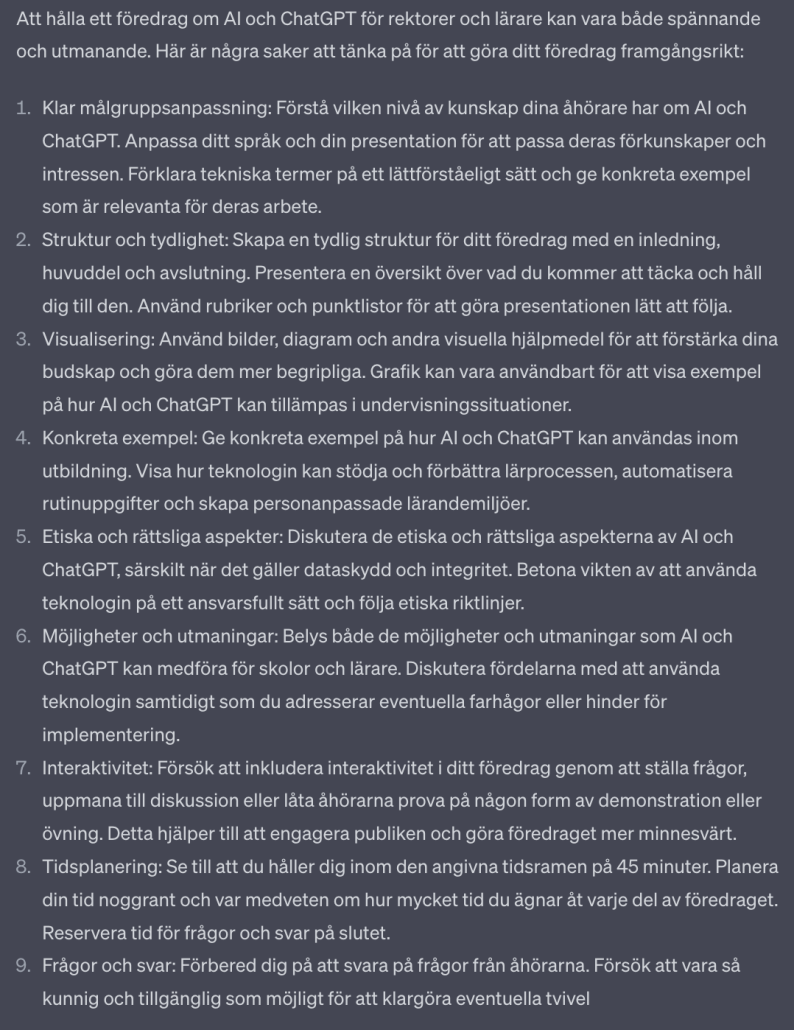
ChatGPT har över 200 miljoner användare, 60 miljoner besökare om dagen.
Databasen består av 300 miljarder ord
Alternativ till ChatGPT:
- Chatsonic (Writesonic)
- OpenAI playground
- Claude
- Bard AI
- LaMDA (Language Model for Dialog Applications)
- Jasper Chat
- Socratic
- Bing AI
- DialoGPT
- Megatron-Turing Natural Language Generation
- Chatsonic on Opera
- NeevaAI
- CoPilot
- Tabnine
- Amazon Codewhisperer
- Elsa Speaks
- Bloom
- DeepL Write
- YouChat
- Perplexity
- Elicit
- Chinchilla
- Replika
- Character AI
- Poe by Quora
- Chatsonic Slack Bot
- CoGram
- Otter
- Botsonic
- LLaMA by Meta
Jag ska hålla föredrag för rektorer och lärare kring AI och Chatgpt, under ca en timme minuter. Vad ska jag tänka på?

Och om jag blir nervös?

Härligt! Då har vi koll på det! Ingen nervositet, vi har koll på vad vi ska snacka om under morgongen!
ChatGPT kan formulera mail…

formulera om mailet, tiden är 09.30 och platsen är I17. Skriv på ett ledigt och insäljande sätt. Skriv som om du vore en säljare.

Men kan ChatGPT vara till hjälp för elever?

Skriv en bokrecension på boken Nybyggarna av vilhem moberg, Skriv som om jag är en gymnasielev och har svårigheter att uttrycka mig perfekt. håll det till ca ett a4.

Skriv om texten som om en 10-åring har skrivit texten, gör också 10 stavfel i texten.

Den kan göra tabeller…

Agera som en lärare…

Och den kan sammanfatta texter, på nästintill alla språk;
Wind turbines work on a simple principle: instead of using electricity to make wind—like a fan—wind turbines use wind to make electricity. Wind turns the propeller-like blades of a turbine around a rotor, which spins a generator, which creates electricity.
Explore a Wind Turbine
Wind is a form of solar energy caused by a combination of three concurrent events:
- The sun unevenly heating the atmosphere
- Irregularities of the earth’s surface
- The rotation of the earth.
Wind flow patterns and speeds vary greatly across the United States and are modified by bodies of water, vegetation, and differences in terrain. Humans use this wind flow, or motion energy, for many purposes: sailing, flying a kite, and even generating electricity.
The terms “wind energy” and “wind power” both describe the process by which the wind is used to generate mechanical power or electricity. This mechanical power can be used for specific tasks (such as grinding grain or pumping water) or a generator can convert this mechanical power into electricity.
A wind turbine turns wind energy into electricity using the aerodynamic force from the rotor blades, which work like an airplane wing or helicopter rotor blade. When wind flows across the blade, the air pressure on one side of the blade decreases. The difference in air pressure across the two sides of the blade creates both lift and drag. The force of the lift is stronger than the drag and this causes the rotor to spin. The rotor connects to the generator, either directly (if it’s a direct drive turbine) or through a shaft and a series of gears (a gearbox) that speed up the rotation and allow for a physically smaller generator. This translation of aerodynamic force to rotation of a generator creates electricity.
Types of Wind Turbines
The majority of wind turbines fall into two basic types:
HORIZONTAL-AXIS TURBINES
VERTICAL-AXIS TURBINES
Wind turbines can be built on land or offshore in large bodies of water like oceans and lakes. The U.S. Department of Energy is currently funding projects to facilitate offshore wind deployment in U.S. waters.

Agera som ett äventyrsspel..

Risker..?
Kreativitetsdödande, plagiering,
Och slutligen…


